A Modern-Day Look at “The Hound of the Baskervilles”
by Kathy Owen, @kbowenwriter
Elizabeth invited me to share with you one of my favorite classic detective novels, Sir Arthur Conan Doyle’s The Hound of the Baskervilles. I love talking about the classics with fellow mystery lovers!
The Hound of the Baskervilles (1901-02) has been regarded by current and contemporary Sherlockians as the best of the four novels. Since its publication, it has been adapted dozens of times for radio, film, and television.
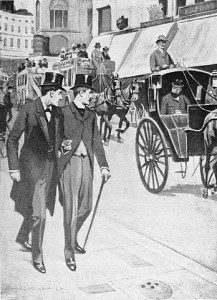
Holmes and Watson. Artist Sidney Paget, 1901. Wikimedia Commons.
Hound beginnings:
The year 1901 marked the death of Queen Victoria and saw Doyle well-established in his career: he had achieved many of his personal goals, and was considered a serious writer and popular public speaker. That year, Doyle went on a golfing holiday in Norfolk with his friend Fletcher Robinson. On a dreary, rainy day, when golfing was out of the question, Robinson passed the time by recounting to Doyle the West Country legend of a spectral hound, which gave Doyle the idea for his story. Blogger and writer Gene Lempp wrote a fascinating post on the Legend of Black Shuck which gives more detail.
Doyle subsequently traveled to the Dartmoor area to get local color for the story, which was originally not intended to feature Holmes (he had already killed off Holmes in “The Final Problem” – pitching him over the Reichenbach Falls with Professor Moriarty). According to Doyle, Holmes sort of worked his way into the story; so, rather than resurrect Holmes (although he did later, in 1903), Doyle made the story a reminiscence by Watson of an earlier undocumented case.
The Hound of the Baskervilles was serialized in The Strand Magazine (where most of the stories were serialized) over a nine-month period, from August 1901 to April 1902. It was eagerly received, and long lines formed at the publisher’s office when the next installment was due out.
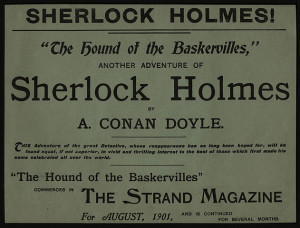
Broadsheet advertisement for The Hound of the Baskervilles, 1901. Wikimedia Commons.
There’s a lot to admire about the novel, but I’ll keep to a few interesting aspects.
Narrative strategies in Hound:
Doyle was master of the cliff-hanger. He knew how to break up the segments to keep the readers hooked. The first magazine installment, for example, ends with Watson’s sleep being disturbed by: “the sob of a woman, the muffled, strangling gasp of one who is torn by uncontrollable sorrow.” Other cliff-hangers involve a dead body, a stealthy stranger, and mysterious noises in the night.
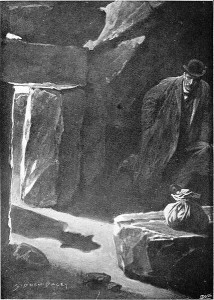
Watson lying in wait for the mysterious stranger. Artist Sidney Paget, 1901. Wikimedia Commons.
In Hound, Doyle was able to resolve the narrative difficulty he’d had in two earlier full-length Holmes novels: how to explain the complex and lengthy series of events that lead up to a crime without the use of long flashbacks or tedious explanations that interrupt the story. Instead, Doyle used different narrative voices: those of the client, a 17th century manuscript, Watson, and Holmes, who later relays his own account of the time when he and Watson are working the case separately.
The separation of the Holmes/Watson team is unusual as well. Without Holmes on the scene to guide him, Watson has his chance in the limelight as a detective. It is a role that weighs heavily on him, however. The reader shares the feeling of vulnerability in Holmes’s absence.
Gothic elements:
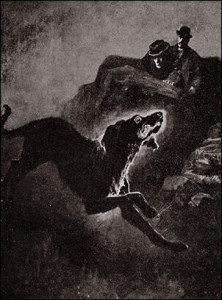
Artist Sidney Paget’s otherworldly hound. Image via wikimedia commons.
The novel’s Gothic horror story trappings make it an unusual setting for a detective story: a family curse, a dark, primitive moor, a seemingly-supernatural hound, a black-hearted villain. There are lots of “thrills and chills.” But it’s a detective story through and through, because the Gothic is not its solution. There is a rational explanation for everything. Some scholars posit this is why Doyle instinctively felt that Holmes belonged in the story.
Psychoanalytic facets of the novel:
During the time that Doyle was writing the Holmes stories, Freud was developing his theories of the unconscious mind and repression. Writers such as Conrad, Stevenson and James wrote symbolic stories in which the source of evil existed within the mad soul and had to be restrained by the intellect. The Hound of the Baskervilles treats the problem of human evil from a psychological perspective rather than a metaphysical/ supernatural one. Scholars like to read the wild, lonely, treacherous moors as symbolic of the repressed unknown unconscious mind, uncivilized and barbaric. Using this interpretation, the moor would act in conjunction with characters in the story (including the neolithic savages, the original inhabitants of the moor) to depict the unconscious, dark side of the human soul, or the primitive part of man existing beneath the civilized veneer, if you will.
There’s more I could say about this (we haven’t even touched Jungian theory), but we want stuff to discuss in the comments section! I hope you’ll give The Hound of the Baskervilles a second (or first) look.
Bio:

K.B. Owen taught college English at universities in Connecticut and Washington, DC and holds a doctorate in 19th century British literature. A long-time mystery lover, she drew upon her teaching experiences in creating the Professor Concordia Wells mystery series. The first book, Dangerous and Unseemly, was published in early 2013.
The second book, Unseemly Pursuits: A Concordia Wells Mystery, has just been released:
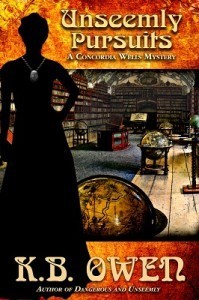
A deadly secret that won’t stay buried…
It is the fall of 1896, and Miss Concordia Wells is hip-deep in the usual tumult of a lady professor’s life: classes, clubs, student pranks, and the unending drama generated by the girls she lives with on campus. Complicating this normality is the new Lady Principal, whom the students have nicknamed “the Ogre.” The woman seems bent on making Concordia’s life miserable.
And then there’s the exotic spirit medium, Madame Durand, who has befriended Concordia’s mother and has started a “Spirit Club” on campus. Madame’s prognostications of doom are at first only mildly irritating – until events take a sobering turn. An ancient Egyptian amulet donated to the college mysteriously disappears, the donor is found murdered, and his daughter – Concordia’s best friend – confesses to killing him.
Desperate for answers, Concordia unravels a 20-year-old secret, closely guarded by men now dead. But such secrets can be dangerous for the daughters left behind, including Concordia herself. Can she make sense of the mystery that has bound together their fates, before it’s too late?
Unseemly Pursuits is available through these venues:
Kathy’s also hosting a giveaway! A randomly-selected winner from the comments section of each guest post on her blog tour (comments up through March 6, 2014) will receive a free e-copy of Unseemly Pursuits. One grand-prize winner from all of the ebook winners will receive an Unseemly Pursuits swag kit! This includes a mug, JellyBelly tin, keychain, and two signed paperbacks: her first novel in the series, Dangerous and Unseemly, along with Unseemly Pursuits. (If the grand-prize winner lives outside the U.S., she or he will receive a $50 Amazon gift card instead, because of the cost of shipping).
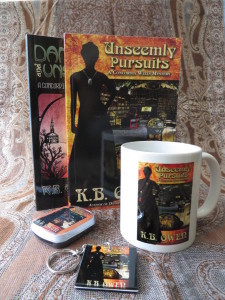
The post A Modern-Day Look at “The Hound of the Baskervilles” appeared first on Elizabeth Spann Craig.



